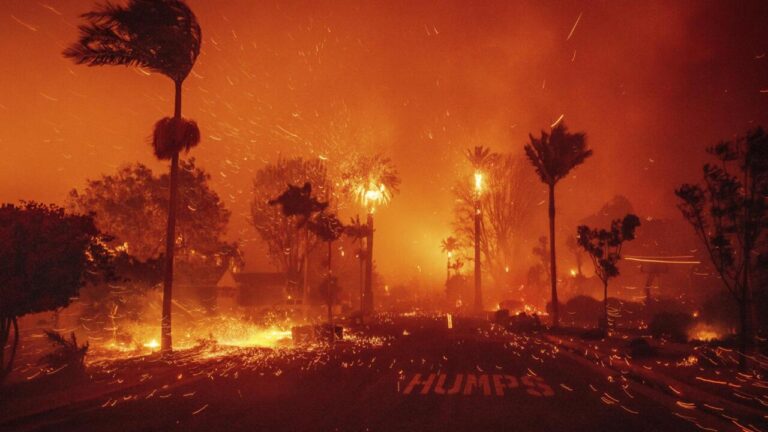Los Angeles Faces Escalating Wildfire Crisis: Impact, Response, and Recovery
Widespread Destruction and Displacement from LA Wildfires
Los Angeles is currently enduring a severe wildfire outbreak that has rapidly consumed vast areas, including residential neighborhoods, parks, and natural reserves. The intense blazes have compelled tens of thousands of residents to evacuate, while emergency responders are stretched thin battling the infernos. The devastation has transformed once-thriving communities into charred landscapes, presenting a formidable challenge for recovery and rebuilding efforts.
Recent assessments reveal the extensive damage inflicted by the fires:
- Residential Losses: More than 1,200 homes have been destroyed or critically damaged.
- Evacuations: Over 24,000 individuals have been displaced, with multiple emergency shelters activated citywide.
- Infrastructure Disruptions: Key roadways remain closed due to fire hazards, and widespread power outages affect thousands of households.
The scale of destruction underscores the urgent need for coordinated recovery strategies and heightened fire prevention measures moving forward.
| Area | Extent of Damage | Current Status |
|---|---|---|
| Residential Zones | Severe | Evacuated |
| Natural Parks & Forests | Extensive Burn | Access Restricted |
| Transportation Routes | Partial Closures | Gradual Reopening |
| Emergency Shelters | Operational | Open |
Intensified Emergency Operations Amid Expanding Fire Zones
Firefighting teams and emergency responders have escalated their efforts to contain the rapidly advancing wildfires. Deploying a combination of aerial water drops and ground-based firefighting units, they face challenging conditions including strong winds and parched landscapes. Key response strategies include:
- Utilization of helicopters and air tankers to deliver water and fire retardants.
- Establishment of multiple evacuation centers to support displaced residents.
- Rapid response squads conducting door-to-door safety checks in vulnerable neighborhoods.
Collaboration between municipal agencies and state emergency services focuses on minimizing casualties and protecting critical infrastructure such as power grids and transportation corridors.
| Metric | Current Figure | Progress Status |
|---|---|---|
| Acres Affected | 12,600+ | Expanding |
| Evacuated Residents | 24,000+ | Active |
| Firefighting Personnel | 1,350 | Deployed |
| Containment Percentage | 18% | Ongoing |
Ecological Consequences and Long-Term Environmental Recovery
The wildfires have inflicted profound damage on Los Angeles’ ecosystems, disrupting habitats and threatening biodiversity. Thick smoke and ash have degraded air quality to hazardous levels, while the destruction of vegetation has left soil exposed and vulnerable to erosion.This environmental upheaval poses risks such as increased flooding and landslides during upcoming rainy seasons.
Key ecological impacts include:
- Loss of native plant species essential for ecosystem balance.
- Displacement and mortality among small mammals,birds,and insect populations.
- Pollution and sedimentation affecting local waterways and aquatic life.
- Elevated carbon emissions contributing to broader climate change challenges.
Restoration efforts, including reforestation and soil stabilization projects, are underway but face notable hurdles due to the scale of destruction.Experts estimate that full ecological recovery could span decades, with some species struggling to reestablish without human intervention.
| Environmental Impact | Immediate Result | Estimated Recovery Period |
|---|---|---|
| Vegetation Destruction | Complete canopy loss | 5 to 20 years |
| Wildlife Habitat Disruption | Loss of shelter and food sources | 10 to 15 years |
| Soil Degradation | Increased erosion and runoff | 3 to 7 years |
| Water Quality Deterioration | Sediment buildup and contamination | 2 to 5 years |
Preparedness and Safety Guidelines for Residents in Vulnerable Zones
For those living in wildfire-prone areas, proactive measures are critical to enhance safety and reduce fire risks. Creating defensible space by removing dry vegetation, dead trees, and combustible debris within at least 30 feet of homes is essential. Regular upkeep of roofs, gutters, and vents to clear flammable materials further mitigates danger.
Residents should also develop emergency interaction plans with family and neighbors to ensure swift information sharing during fire alerts. Preparing an emergency kit containing important documents, food, water, medications, and protective masks is highly recommended. Staying updated through official channels and wildfire tracking applications can provide timely warnings, while participating in community evacuation drills improves readiness.
- Maintain a 30-foot defensible zone around your property.
- Install fire-resistant building materials such as roofing and windows.
- Keep emergency supplies including N95 masks, gloves, and essential medications.
- Monitor evacuation routes and alerts regularly.
- Evacuate promptly when instructed by authorities.
| Preparedness Item | Recommended Action |
|---|---|
| Defensible Space | Clear brush and debris within 30 feet |
| Protective Equipment | Keep masks and gloves accessible |
| Information Access | Use official apps and local alerts |
| Emergency Kit | Stock with essentials and documents |
| Community Coordination | Engage in evacuation drills |
Looking Ahead: Lessons and Ongoing Challenges
As the wildfires continue to ravage Los Angeles, the profound impact on communities and ecosystems becomes increasingly evident. The crisis highlights the urgent need for enhanced climate resilience, improved fire management strategies, and community preparedness. Authorities emphasize the importance of adhering to evacuation orders and staying informed through reliable sources.
Ongoing coverage will track recovery progress and evolving response efforts, underscoring the critical role of collective action in confronting the growing threat of wildfires intensified by climate change.




